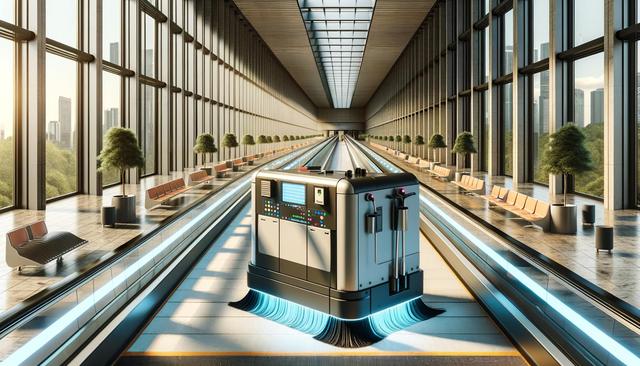The Importance of Escalator Hygiene in Public Areas
Escalators are an essential part of urban infrastructure, moving thousands of people daily through shopping centers, airports, metro stations, and office buildings. However, due to their high traffic and complex structure, they can become hotspots for dirt accumulation and bacterial growth if not properly maintained. Dust, grease, and debris can settle in the grooves of the escalator steps and tracks, leading not only to poor aesthetics but also to potential safety hazards such as slippage or mechanical failure. Regular cleaning is therefore not just about appearance—it’s a matter of public safety and functionality.
Manual cleaning methods often fall short, especially in high-traffic environments where downtime must be limited. Escalator cleaning machines serve as an efficient alternative, offering fast, deep cleaning that helps prevent hazards and maintain operational reliability. These machines play a crucial role in keeping public spaces sanitary and safe for all users.
How Automated Escalator Cleaning Machines Work
Automated escalator cleaning machines are engineered to thoroughly clean both the visible steps and the internal mechanisms of escalators with minimal human intervention. Their design typically includes rotating brushes, vacuum systems, and cleaning solution dispensers that work together to remove dirt and grime embedded in the grooves of the steps. Most models are compact and lightweight, allowing for easy transport and setup.
Here’s how a typical cleaning cycle works:
- The machine is positioned at the base or top of the escalator while the escalator is turned off.
- Cleaning brushes and pads engage with the step grooves as the escalator slowly moves in manual mode.
- Detergents are applied and immediately scrubbed in, breaking down tough grime.
- Vacuum systems and squeegees remove dirty water and residue, leaving the surface clean and dry.
Some advanced models offer adjustable brush pressure and programmable cleaning modes, making them versatile for different escalator designs and levels of soiling.
Benefits of Using Escalator Cleaning Machines
Integrating escalator cleaning machines into regular maintenance routines yields multiple operational and safety benefits. These machines not only improve cleaning consistency but also reduce the need for labor-intensive manual work, saving time and resources over the long term. More importantly, they contribute to a safer environment by minimizing slip risks and mechanical wear caused by accumulated debris.
Key advantages include:
- Enhanced hygiene in high-traffic areas
- Shorter downtime due to faster cleaning cycles
- Prolonged equipment lifespan by preventing buildup in mechanical parts
- Reduced labor costs and risk of injury for cleaning staff
These benefits make automated solutions an attractive option for facility managers seeking to maintain both cleanliness and safety standards in public infrastructure.
Considerations When Choosing a Cleaning Machine
When selecting an escalator cleaning machine, several factors should be evaluated to ensure it aligns with the facility’s needs. First, the size and type of escalators in use determine the machine’s compatibility. For instance, wider or unusually designed steps may require specialized brushes or configurations. Also, facilities with limited access or narrow maintenance areas might benefit from more compact models that are easier to maneuver.
Other important considerations include:
- Cleaning speed and capacity – how many escalators can be cleaned in a given time frame
- Ease of use – intuitive controls and quick setup for minimal training
- Maintenance requirements – how often the machine needs servicing or replacement parts
- Noise levels – important for cleaning during operating hours without disturbing patrons
Choosing the right equipment involves balancing performance capabilities with operational constraints, ensuring the machine supports rather than hinders daily facility operations.
Integration into Facility Maintenance Programs
For escalator cleaning machines to deliver their full value, they should be integrated into a comprehensive facility maintenance schedule. This includes routine inspections, regular cleaning intervals, and documentation of maintenance activities. By scheduling cleanings during off-peak hours, disruptions to foot traffic can be minimized, ensuring consistent accessibility and cleanliness.
Facilities that implement structured cleaning programs often see measurable improvements in user satisfaction and a reduction in escalator-related incidents. Collaboration between maintenance teams and machine operators is essential for achieving optimal outcomes. Training staff on equipment use and basic troubleshooting can further enhance efficiency and prevent unnecessary delays.
Incorporating feedback from users and maintenance personnel also helps refine cleaning schedules and adjust practices based on escalator usage patterns. This proactive approach supports long-term asset management and contributes to a safer, more pleasant public environment.
Conclusion: Prioritizing Safety Through Technology
Escalator cleaning machines offer a practical and effective solution for maintaining cleanliness and safety in busy public spaces. By automating a traditionally challenging task, these machines reduce operational burdens while improving hygiene and equipment reliability. For facility managers focused on public safety, integrating automated cleaning into their maintenance strategy is a forward-thinking step that supports both daily functionality and long-term infrastructure health.




Leave a Reply